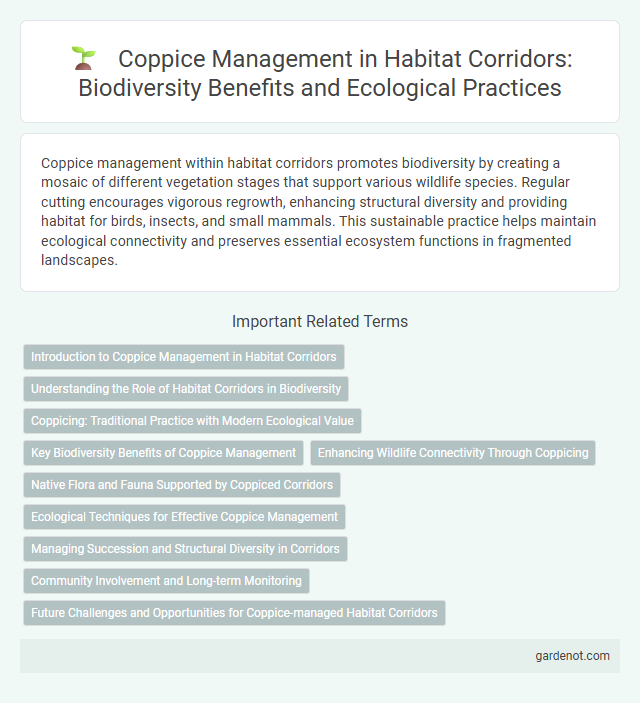Coppice management within habitat corridors promotes biodiversity by creating a mosaic of different vegetation stages that support various wildlife species. Regular cutting encourages vigorous regrowth, enhancing structural diversity and providing habitat for birds, insects, and small mammals. This sustainable practice helps maintain ecological connectivity and preserves essential ecosystem functions in fragmented landscapes.
Introduction to Coppice Management in Habitat Corridors
Coppice management in habitat corridors involves the systematic cutting and regrowth of trees and shrubs to enhance biodiversity and promote sustainable forest structure. This technique fosters a mosaic of habitats by encouraging diverse plant species and providing shelter for various wildlife, contributing to ecological connectivity. Effective coppicing supports the regeneration of native flora while maintaining the corridor's role as a vital link between fragmented ecosystems.
Understanding the Role of Habitat Corridors in Biodiversity
Coppice woodland, characterized by periodic cutting to promote regrowth, serves as a vital habitat corridor facilitating species movement and genetic exchange. These corridors enhance biodiversity by connecting fragmented habitats, allowing flora and fauna to disperse, forage, and reproduce more effectively. Maintaining and restoring coppice corridors supports ecosystem resilience and the conservation of rare species dependent on this dynamic environment.
Coppicing: Traditional Practice with Modern Ecological Value
Coppicing, an ancient woodland management technique, involves periodically cutting trees to ground level to stimulate new growth and enhance biodiversity. This practice creates diverse habitat structures that support a wide range of species, including rare invertebrates and ground-nesting birds. Modern ecological restoration projects utilize coppicing to maintain habitat corridors, promoting connectivity and resilience in fragmented landscapes.
Key Biodiversity Benefits of Coppice Management
Coppice management promotes key biodiversity benefits by creating a diverse age structure in woodland habitats, supporting a wide range of flora and fauna. Regular cutting cycles increase light penetration to the forest floor, encouraging understorey growth and providing habitats for pollinators, birds, and small mammals. This method enhances habitat connectivity within habitat corridors, facilitating species movement and genetic exchange essential for ecosystem resilience.
Enhancing Wildlife Connectivity Through Coppicing
Coppicing revitalizes woodlands by periodically cutting trees to ground level, promoting diverse habitat structures critical for various wildlife species. This traditional silviculture method enhances habitat connectivity by supporting populations of woodland birds, insects, and small mammals that rely on a mosaic of light conditions and vegetation layers. Implementing coppice practices within habitat corridors strengthens ecological networks, facilitating species movement and genetic exchange across fragmented landscapes.
Native Flora and Fauna Supported by Coppiced Corridors
Coppiced corridors play a vital role in supporting native flora and fauna by creating diverse habitats rich in understorey plants and young trees. These managed woodlands provide shelter and breeding grounds for species such as dormice, nightingales, and various butterfly species, enhancing local biodiversity. The cyclical cutting in coppicing encourages the growth of native wildflowers and fungi, which sustains pollinators and decomposers essential to ecosystem health.
Ecological Techniques for Effective Coppice Management
Effective coppice management relies on ecological techniques such as rotational cutting to promote biodiversity and maintain habitat continuity within habitat corridors. Implementing variable cutting cycles encourages diverse age structures in woodland, enhancing species richness and resilience. Integrating native species selection and minimal soil disturbance further supports ecological balance and habitat connectivity.
Managing Succession and Structural Diversity in Corridors
Coppice management in habitat corridors promotes structural diversity by regularly cutting trees to stimulate regrowth at various stages, which supports a range of wildlife species. Managing succession through coppicing prevents uniform canopy closure, maintaining open spaces essential for sun-loving plants and ground-dwelling fauna. This practice enhances biodiversity and ensures ecological connectivity by creating varied habitats within corridor networks.
Community Involvement and Long-term Monitoring
Coppice management fosters community involvement by engaging local residents in traditional woodland stewardship, enhancing biodiversity through sustainable harvesting practices. Long-term monitoring of coppice habitats tracks species diversity and habitat health, enabling adaptive management and conservation planning. Active participation and consistent data collection ensure the resilience and ecological integrity of habitat corridors over time.
Future Challenges and Opportunities for Coppice-managed Habitat Corridors
Coppice-managed habitat corridors face future challenges such as climate change-induced shifts in species distribution and invasive species encroachment, which threaten biodiversity and ecosystem stability. Opportunities lie in integrating advanced remote sensing technology and adaptive management practices to enhance corridor connectivity and sustain habitat quality. Long-term monitoring and community engagement are critical to balancing resource use with conservation goals in coppiced landscapes.
Coppice Infographic

 gardenot.com
gardenot.com